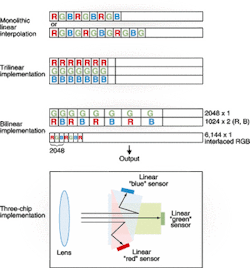Linescan color cameras abound
CCD linescan cameras have several advantages over their area-array counterparts, including high optical linear resolution that allows systems developers to use the cameras to capture two-dimensional (2-D) images by moving the object or the CCD perpendicularly to the scan line. In the past, the lack of high-speed camera interfaces and host bus-transfer rates somewhat limited the choice to gray-scale linescan cameras. Now, with the introduction of 64-bit, 66-MHz PCI bus interfaces and the high-speed Camera Link interface, more manufacturers are offering linescan color cameras (see table).
"Most available color linescan cameras use prism-based designs to split incoming white light into R, G, and B components," says Christophe Robinet, camera marketing manager at Atmel (Grenoble, France). This method produces the best optical results and is the suitable solution for high-end applications where color separation is critical, although at a high price. "Such cameras require a beamsplitter, three CCDs, and three processing chains and must be used with high-end optics," he says, "which adds to the expense of the cameras."
At the recent Photonics Boston, Atmel announced two such prism-based cameras—the Akyla MD-20 and the MD-30. Operating at pixel rates of 20 and 30 MHz, respectively, these cameras feature three independent CCD devices (available in resolutions of 1024 or 2048 pixels) and can output a 10-bit dynamic range; they support LVDS or CameraLink interfaces.
Multiline monochip camera
Other methods of producing linescan color cameras include both bilinear and trilinear implementations. A novel bilinear method used in the design of the CCL3x2048RVB camera from Lord Ingeniere (Corbreuse, France; www.lord-ing.com) has a camera with a linear image sensor consisting of two adjacent lines of pixels. Whereas the first line consists of 2048 × 1 green pixels, the second line has 1024 pixels interfaced with 1024 blue pixels (see figure). Digital signal processing on the CCD's output then generates a 6144-pixel line output consisting of 2048 RGB triplets.
In the development of color CCD cameras several implementations can be used depending on the price/performance required. While the single-line color-patterned CCD offers the simplest imple-mentation (top), three-chip prism-based designs are often used in more spectrally demanding high-speed applications.
Unlike bilinear implementations, cameras based on trilinear CCDs use separate sensor lines for R, G, and B, and, after each line exposure, these RGB pixels are output sequentially from the camera. Based on a trilinear, progressive-scan CCD sensor with 2098 pixels in each line, the L301kc from Basler AG (Ahrensburg, Germany; www.basler-vc.com) is an example of such a camera. "The basic price of the L301kc is competitive when compared to three-chip color cameras. And when you consider that the L301kc does not require a matched lens for optimum image quality as three-chip cameras do, it stands out as a cost-effective solution for color image capture," says Basler product manager Ingo Lewerendt.
"While this is true," says Robinet, "implementing a multiline camera still requires a perfectly synchronized camera vs. moving object and needs to bypass all line registration challenges."
Single-line color camera
At Photonics Boston Atmel introduced its Aviiva C2A—a new alternative to the cost-effective color linescan platform, based on a single-line, 4096-pixel, high-speed chip with RGB filters (that is, an array of 1365 RGB patterns). "Able to run up to 60 MHz (pixel rate), this new camera can be used either in 8- or 12-bit mode and can output 1365 RGB sequential triplets or 4094 interpolated pixels in parallel with R, G, and B information for each." Its implementation is as easy as a monochrome camera (using the provided IR filter), and it uses common lenses. The introductory price is less than 30% of current prices of three-chip cameras.


